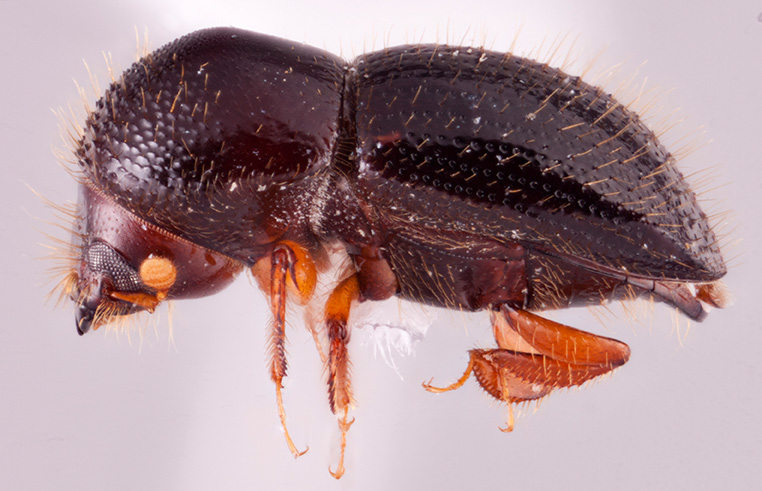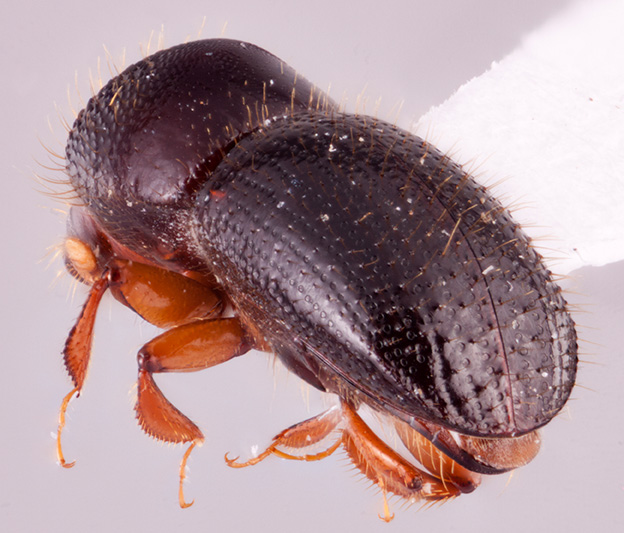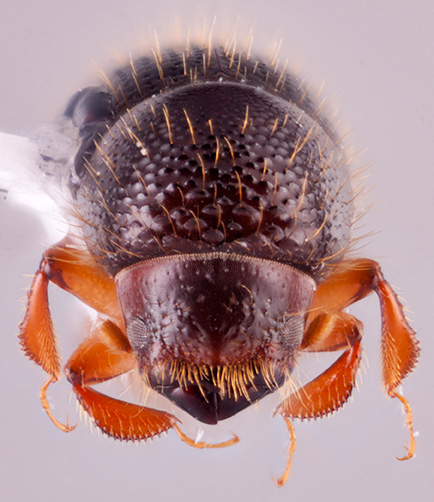Euwallacea interjectus
|
Euwallacea interjectus lateral; R.K. Osborn |
|
Euwallacea interjectus dorsal; R.K. Osborn |
|
Euwallacea interjectus declivity; R.K. Osborn |
|
Euwallacea interjectus frontal; R.K. Osborn |
Taxonomic history
Xyleborus interjectus Blandford, 1894c: 576.
Euwallacea interjectus (Blandford): Saha and Maiti, 1984: 2.
Synonyms
Xyleborus pseudovalidus Eggers, 1925: 159. Schedl, 1958a: 155.
Diagnosis
3.5−3.9 mm long (mean = 3.78 mm; n = 5); 2.4−2.64 times as long as wide. This species is distinguished by the pronotumpronotum:
the dorsal surface of the thorax
appearing subquadratesubquadrate:
almost quadrate, with oblique corners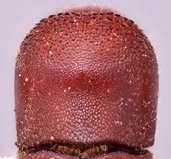 (type 3) from dorsaldorsal:
(type 3) from dorsaldorsal:
of or relating to the upper surface; opposite of ventral
 view; outer margin of protibiaprotibia:
view; outer margin of protibiaprotibia:
tibia of the first pair of legs
round; declivitaldeclivital:
pertaining to the elytral declivity
interstriae 1 granulategranulate:
pertaining to a coarse, grainy surface texture
 ; posterolateralposterolateral:
; posterolateralposterolateral:
relating to end of the side part/portion
 costacosta:
costacosta:
elevated ridge that is rounded at its crest, not necessarily with sharp appearance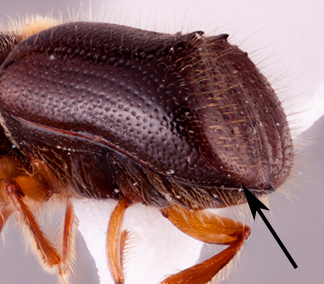 smooth, never granulategranulate:
smooth, never granulategranulate:
pertaining to a coarse, grainy surface texture
 ; and moderately large size.
; and moderately large size.
It can be further separated from the strongly morphologically similar species E. validus by the gradually sloped declivitydeclivity:
downward slope of either the pronotum or elytra
 ; declivitaldeclivital:
; declivitaldeclivital:
pertaining to the elytral declivity
strial punctures shallow giving the declivitydeclivity:
downward slope of either the pronotum or elytra
 a smooth appearance; and tuberclestubercle:
a smooth appearance; and tuberclestubercle:
a small knob-like or rounded protuberance of the exoskeleton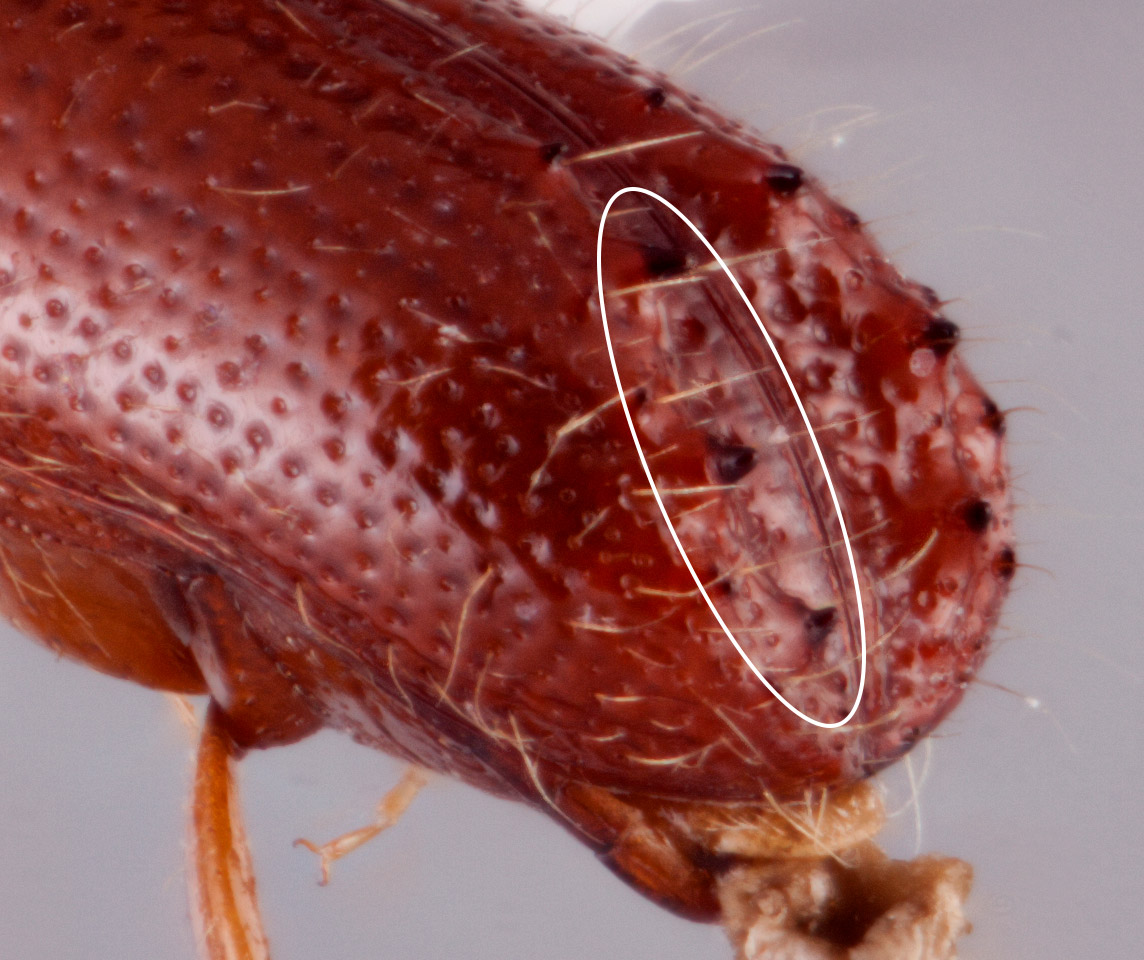 on interstriaeinterstria:
on interstriaeinterstria:
longitudinal spaces along the elytra between the striae, which is not as<br />
impressed and bear smaller punctures.
 2 extending from basebase:
2 extending from basebase:
point or edge closest to the body; opposite of apex to apexapex:
to apexapex:
point or edge furthest from the body; opposite of base
 .
.
May be confused with
Euwallacea funereus, E. validus, and E. velatus
Distribution
from the Indian subcontinent and China through Southeast Asia and Indonesia to the Philippines, New Guinea and Solomon Islands; introduced to North America, Hawaii and South America (Argentina) (Halbert 2011Halbert 2011:
Halbert SE. 2011. Entomology Section. Tri-ology 50: 6-7., Cognato et al. 2015Cognato et al. 2015:
Cognato AI, Hoebeke ER, Kajimura H, Smith SM. 2015. History of the exotic ambrosia beetles Euwallacea interjectus and Euwallacea validus (Coleoptera: Curculionidae: Xyleborini) in the United States. Journal of Economic Entomology 108: 1129-1135. https://doi.org/10.1093/jee/tov073, Gomez et al. 2018bGomez et al. 2018b:
Gomez DF, Skelton J, Steininger MS, Stouthamer R, Rugman-Jones P, Sittichaya W, Rabaglia RJ, Hulcr J. 2018b. Species within the Euwallacea fornicatus (Coleoptera: Curculionidae) complex revealed by morphometric and phylogenetic analyses. Insect Systematics and Diversity 2(6): 2, 1-11. https://doi.org/10.1093/isd/ixy018; Landi et al. 2019Landi et al. 2019:
Landi L, Braccini CL, Kniacute;žek M, Pereyra VA, Marvaldi AE. 2019. A newly detected exotic ambrosia beetle in Argentina Euwallacea interjectus (Coleoptera: Curculionidae: Scolytinae). Florida Entomologist 102: 240-242. https://doi.org/10.1653/024.102.0141); recorded in the study region from Bangladesh, Bhutan, China (Anhui, Chongqing, Fujian, Gansu, Guandong, Guizhou, Hainan, Hong Kong, Hubei, Hunan, Jiangsu, Jiangxi, Sichuan, Yunnan, Xizang), India (Andaman Is, Arunachal Pradesh, Assam, Kerala, Madhya Pradesh, Maharashtra, Meghalaya, Sikkim, Tamil Nadu, Uttarakhand, West Bengal), South Korea, Laos, Myanmar, Nepal, Taiwan, Thailand, Vietnam
Host plants
polyphagous (Beeson 1930Beeson 1930:
Beeson CFC. 1930. The biology of the genus Xyleborus , with more new species. Indian Forest Records 14: 209-272., Browne 1961bBrowne 1961b:
Browne FG. 1961b. The biology of Malayan Scolytidae and Platypodidae. Malayan Forest Records 22: 1-255.)
DNA data
Sequences available for COI and CAD.
COI: MN619930; MN619931; MN619932; MN619933; MN619934; MN619935; MN619936; KP250565; KP250550; KP250573; KP250574; KP250567
CAD: MN620204; MN620205; MN620206; MN620207; MN620208; MN620209; MN620210; MN620211
Additional COI sequences from across Asian and North Ameircan populations are given in Cognato et al. 2015.

